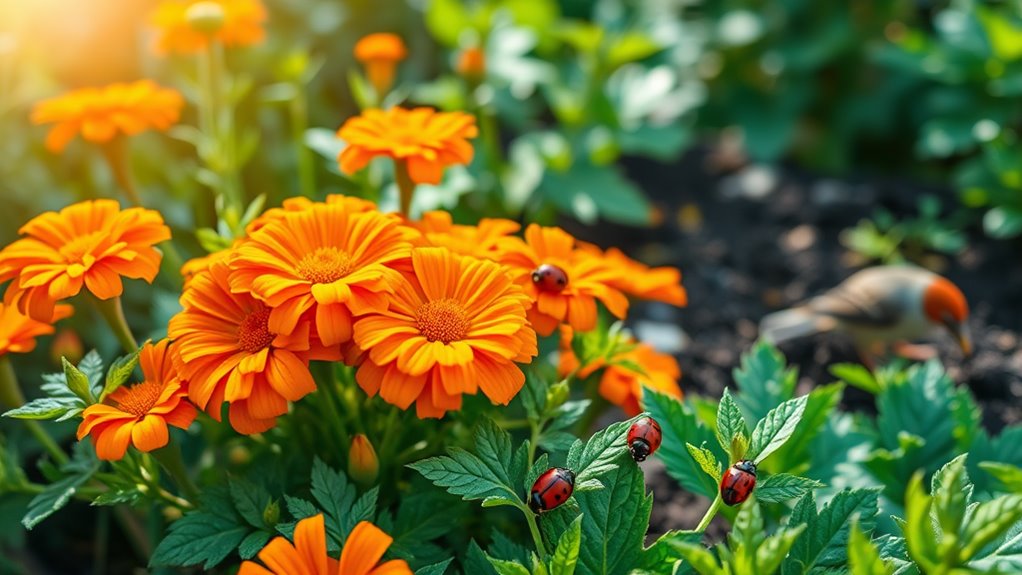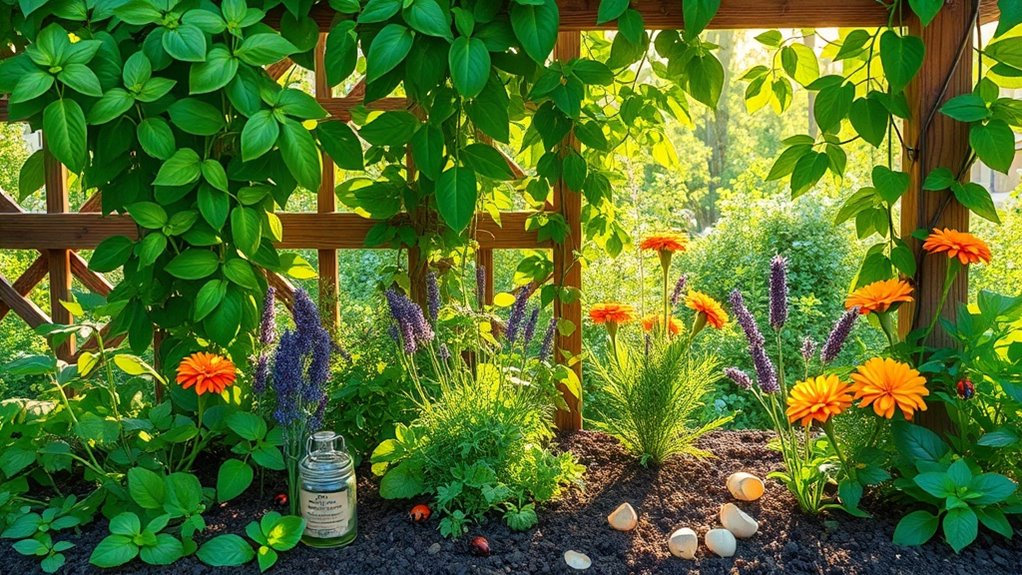These Natural Pest Control Methods Actually Work!
Natural pest control methods are effective and evidence-based. Using essential oils like lavender and peppermint, you can repel harmful insects while promoting a healthier garden ecosystem. Diatomaceous earth damages pests’ exoskeletons, leading to dehydration and death, and homemade insecticidal soaps suffocate soft-bodied pests. Companion planting attracts beneficial insects, and organic mulching suppresses weeds and enhances soil health. By implementing these strategies, you can create a thriving garden. Explore the various techniques to enhance your pest management efforts.
Essential Oils as Natural Repellents
Essential oils have gained recognition as effective natural repellents, offering an eco-friendly alternative to synthetic pesticides.
Research indicates that certain essential oils, like lavender and peppermint, act as natural insecticides, deterring pests without harmful chemicals.
Their active compounds disrupt insect pheromones or create an inhospitable environment.
You’ll find that oils can be easily applied in dilutions or sprays, making them user-friendly options for pest control.
Additionally, studies suggest these oils possess antifungal and antibacterial properties, enhancing their utility in holistic pest management. Furthermore, using natural pest sprays can significantly contribute to maintaining a healthy garden ecosystem.
Diatomaceous Earth for Pest Control
Diatomaceous earth (DE) works by causing dehydration in pests due to its abrasive properties, effectively disrupting their exoskeletons.
To maximize its efficacy, you should apply it in a thin, even layer in areas where pests are active, ensuring it remains dry for best results. Understanding these application techniques can greatly enhance your pest control efforts while minimizing chemical usage. Additionally, natural methods like introducing beneficial insects can also help deter pests in your garden.
How It Works
How does diatomaceous earth effectively combat pests? This natural substance contains sharp, microscopic particles that damage the exoskeletons of insects upon contact, leading to dehydration and death. Its effectiveness lies in the silica content, which disrupts the pest’s ability to retain moisture.
| Property | Effect on Pests |
|---|---|
| Silica Composition | Dehydrates exoskeletons |
| Particle Size | Microscopic, sharp edges |
| Natural Insecticide | Non-toxic to humans/animals |
Application Techniques
When applying diatomaceous earth for pest control, it’s crucial to focus on technique to maximize its effectiveness.
First, make sure the area is dry, as moisture diminishes its abrasive properties. Use a dust applicator for even distribution, targeting cracks, crevices, and entry points where pests may hide. Aim for a light, even coating—too much can repel insects instead of killing them.
Reapply after rain or cleaning. For indoor use, avoid areas where food is prepared.
Monitor pest activity to determine effectiveness and adjust application as needed. Proper technique enhances diatomaceous earth’s ability to dehydrate and eliminate unwanted pests effectively.
Homemade Insecticidal Soap Recipes
While commercial insecticides can be effective, many gardeners prefer homemade insecticidal soaps for their simplicity and reduced chemical exposure. These soaps work by suffocating soft-bodied insects like aphids and spider mites. Additionally, using natural ingredients in your pest control methods can enhance a healthy garden while minimizing chemical use.
To create your own, consider these recipes:
- Basic Soap Mixture: Mix 1 tablespoon of liquid soap (not detergent) with 1 quart of water.
- Oil-Infused Soap: Combine 1 tablespoon of liquid soap with 2 tablespoons of vegetable oil and 1 quart of water.
- Garlic Soap: Blend 1 clove of garlic with 1 quart of water and add 1 tablespoon of soap.
- Herbal Soap: Steep herbs like rosemary or mint in water, strain, and mix with soap.
Attracting Beneficial Insects
To attract beneficial insects, you’ll want to focus on planting nectar-rich flowers that provide essential food sources. Providing shelter options, such as insect hotels or native plant clusters, enhances habitat and encourages insect populations. Additionally, promoting diversity in your garden through various plant species can create a balanced ecosystem that supports these helpful insects. Incorporating butterfly-friendly flowers into your garden can also significantly increase the presence of beneficial insects.
Planting Nectar-Rich Flowers
How can you enhance your garden’s ecosystem and naturally control pests?
One effective strategy is planting nectar-rich flowers that attract beneficial insects.
These insects, such as pollinators and predators, help maintain balance in your garden.
Consider the following:
- Diverse Plant Selection: Choose a variety of flowers that bloom at different times.
- Native Species: Opt for local flora that naturally attracts native beneficial insects.
- Continuous Bloom: Make sure there’s always something in flower to provide a consistent food source.
- Companion Planting: Integrate flowers with vegetables to deter pests while inviting helpers.
Implementing these tactics can greatly improve your garden’s health.
Providing Shelter Options
Creating a habitat for beneficial insects in your garden is essential for fostering a thriving ecosystem.
Providing shelter options, such as insect hotels or undisturbed areas with native grasses and plants, encourages predatory insects like ladybugs and lacewings to settle in.
Research shows that incorporating diverse structural habitats increases insect populations and their predation rates on pests.
Make sure your shelters have various sizes and materials, as specific insects prefer different environments.
Additionally, leaving some areas of bare soil can attract ground-nesting pollinators.
Encouraging Diversity in Garden
Why is attracting a diverse array of beneficial insects essential for your garden’s health?
These insects not only pollinate your plants but also naturally control pest populations, enhancing biodiversity and ecosystem resilience.
To effectively encourage beneficial insects, consider these strategies:
- Plant Native Flora: Native plants attract local beneficial species.
- Create Diverse Habitats: Incorporate flowers, shrubs, and ground covers to provide varied environments.
- Avoid Pesticides: Chemicals can deter beneficial insects, disrupting natural balance.
- Provide Water Sources: Small water features or shallow dishes can attract various insects.
Companion Planting Strategies
Companion planting strategies offer an effective approach to natural pest control, leveraging the synergistic relationships between different plant species to deter pests and enhance growth.
By planting compatible species together, you can exploit natural defenses and attract beneficial insects.
For instance, marigolds release compounds that repel nematodes, while basil can deter flies and mosquitoes when planted near tomatoes.
Research shows that certain combinations, like corn with beans, improve nutrient uptake and reduce pest populations. Additionally, utilizing effective companion planting strategies can significantly enhance your garden’s resilience against pests and diseases.
Understanding these relationships allows you to create a balanced ecosystem in your garden, ultimately leading to healthier plants and reduced reliance on chemical pesticides.
Natural Traps for Common Pests
Natural traps are an excellent solution, leveraging the pests’ behaviors against them. Here are four effective natural traps you can use:
- Sticky Traps: These capture flying insects like aphids and whiteflies using non-toxic adhesive.
- Beer Traps: Slugs and snails are lured to beer, drowning in the liquid.
- Fruit Traps: Overripe fruit attracts fruit flies, which you can then dispose of easily.
- Soap Water Traps: A mixture of soap and water can kill soft-bodied pests like aphids upon contact.
Implementing these traps not only helps in pest control but also contributes to creating a pest-free garden that supports a balanced ecosystem.
Organic Mulching Techniques
Organic mulching techniques serve as an essential strategy in sustainable gardening, enhancing soil health and pest management.
By applying materials like straw, wood chips, or leaves, you create a barrier that suppresses weeds and retains moisture.
This not only prevents competition for nutrients but also fosters beneficial microorganisms in the soil.
The decomposition of organic matter enriches the soil with nutrients, promoting plant vigor.
Additionally, mulching disrupts pest life cycles by providing a less hospitable environment for harmful insects, therefore reducing infestations.
Implementing these techniques effectively can lead to healthier plants and a more productive garden ecosystem. Furthermore, using transformative power of mulch can significantly improve your garden’s overall health and resilience.





